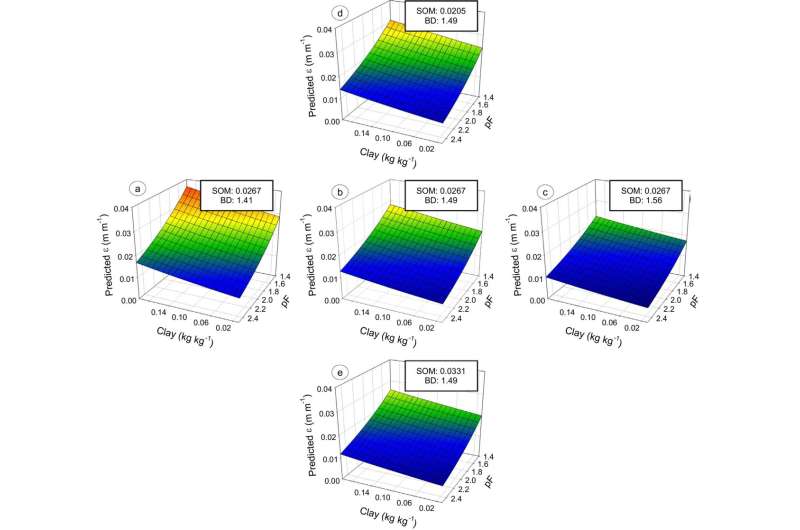Predicting how topsoil is affected by field traffic

Heavy machinery in the field can compress the soil, which can affect both plant growth and environmental conditions. However, it is important to know the difference between soil compaction in the lower layers of the soil and in the top 20 cm or so, which for plowed soil corresponds to the plow layer, also called topsoil.
Compaction of the lower layer of soil causes long-term damage, which is very important to avoid. In the case of the topsoil, compaction can be corrected through tillage, temperature changes from frost to thaw or rain and drought, and soil microbial activity.
“Nevertheless, it is common knowledge that the structure of the top layer of the soil greatly affects crop yield. Here we find a large pool of decomposable organic matter and a lively biological activity. A very large part of the root mass of plants is found in the topsoil. This means that non-optimal conditions for the oxygen-demanding chemical and biological processes can impair the crop’s utilization of nutrients and lead to emissions of nitrous oxide and other gases. Therefore, it is extremely important that we also investigate the process of compaction of the topsoil,” says senior researcher and emeritus Per Schjønning from the Department of Agroecology at Aarhus University.
In a recent scientific article entitled “An empirical model for prediction of topsoil deformation in field traffic” and published in Soil and Tillage Research, he has presented a new model that can predict the deformation of the topsoil caused by agricultural machinery.
For the lower soil layers, there is a certain amount of pressure that must not be exceeded to avoid damage to the soil. It is assumed that the soil is elastic up to this amount of pressure. The topsoil, on the other hand, consists of a mixture of large and small crumbs and clods that gradually deform. Therefore, a different approach is needed. A freshly plowed soil can actually be too loose. This is one of the reasons why furrow packers and rollers are used. On the other hand, the soil must not be compacted too much either. Therefore, a tool is needed to predict how much a given traffic compacts the soil.
The research is based on extensive field studies where Schjønning and his colleagues have measured and analyzed the mechanical forces under tires and the physical changes that occur in the topsoil as a result of field traffic over the course of many years. Based on the collected data and advanced statistical methods, he has developed an empirical model that can estimate the deformation of the topsoil.
“The model takes into account various soil properties—organic matter content, density before traffic, clay and water content. Similarly, knowledge of wheel load, tire type, and recommended and applied tire pressure is used. When we combine all these variables, the model can provide an estimate of the expected deformation in the topsoil. This can be extremely valuable knowledge for agricultural advisors and not least the farmer himself,” explains Schjønning.
The new model has the potential to improve planning and management of agricultural activities. When the farmer has an accurate prediction of what will happen to the density of the topsoil if he chooses to drive a particular machine on a given field at a given time, he can more easily optimize the conditions for crop growth.
“This makes it easier for the farmer to choose the wheel fitment, weight and tire pressure of the machines, as well as the optimal time (moisture content) for a particular operation in the field,” he says.
The model’s application in practice
The model is based primarily on Danish soils, which are relatively sandy. If the model is to be applied more generally at an international level, it will require testing on more clayey soils and possibly adjusting it based on additional measurements. In addition, the shear forces that occur under traction wheels may give rise to skewed results.
“Our research group at Aarhus University has already developed a decision support system that makes it possible to simulate the traffic situation for the protection of the subsoil. It will be possible to incorporate the new model into this system and thus provide more realistic and relevant advice regarding the topsoil,” explains Per Schjønning.
More information:
Per Schjønning, An empirical model for prediction of topsoil deformation in field traffic, Soil and Tillage Research (2022). DOI: 10.1016/j.still.2022.105589
Citation:
Predicting how topsoil is affected by field traffic (2023, July 3)
retrieved 3 July 2023
from https://phys.org/news/2023-07-topsoil-affected-field-traffic.html
This document is subject to copyright. Apart from any fair dealing for the purpose of private study or research, no
part may be reproduced without the written permission. The content is provided for information purposes only.
For all the latest Science News Click Here
For the latest news and updates, follow us on Google News.

